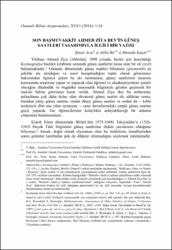Son Başmuvakkit Ahmed Ziya Bey’in Güneş Saatleri Tasarımıyla İlgili Bir Yazısı
Citation
ACAR, Şinasi, Atilla BİR & Mustafa KAÇAR. "Son Başmuvakkit Ahmed Ziya Bey’in Güneş Saatleri Tasarımıyla İlgili Bir Yazısı". Osmanlı Bilimi Araştırmaları, 16.1 (2014): 1-18.Abstract
İslam’da namaz saatleri Güneş’in yerel konumuna göre tanımlanır. İslam toplumları bu ihtiyaçlarını en kolay şekilde yerine getirebilmek için genellikle Güneş saatlerinden yararlanmışlardır. İslam gökbilimcileri ve muvakkitleri, güneş saati bilimini (gnomonik) yüzyıllar boyu incelemişler ve bu konuda eserler yazmışlardır. Bu geleneğin son temsilcilerinden biri, son Osmanlı başmuvakkiti Ahmed Ziya [Akbulut]’dur. Ahmed Ziya Bey’in askeri lise öğrencileri için hazırladığı Kozmografya (Istanbul, 1898) adlı ders kitabının sonunda, güneş saatlerinin yapımı hakkında bir ek bulunmaktadır.. Bu ekte geleneksel yaklaşımın dışına çıkılarak, tasarlanabilecek yatay ve düşey Güneş saatlerinin, basit bir izdüşüm yöntemiyle üniversal ekvatoral güneş saatinden nasıl kolayca türetilebileceği gösterilmiştir. In Islam the prayer times are defined, according to the local position of the Sun. Therefore, sundials are generally used to designate the prayer times in Muslim communities. Islamic astronomers and timekeepers authored many treatises related to the theory and application of gnomonic. A representative of this tradition is the last Ottoman chief-timekeeper Ahmed Ziya [Akbulut]. He compiled a textbook on cosmography in 1898 for the military academy Mekteb-i Harbiye, Istanbul. The book includes an appendix accounting for the design of the sundials. In this appendix, leaving aside the traditional methods, he explained how horizontal and vertical sundials were practically designed by projecting a universal equatorial sundial.



















